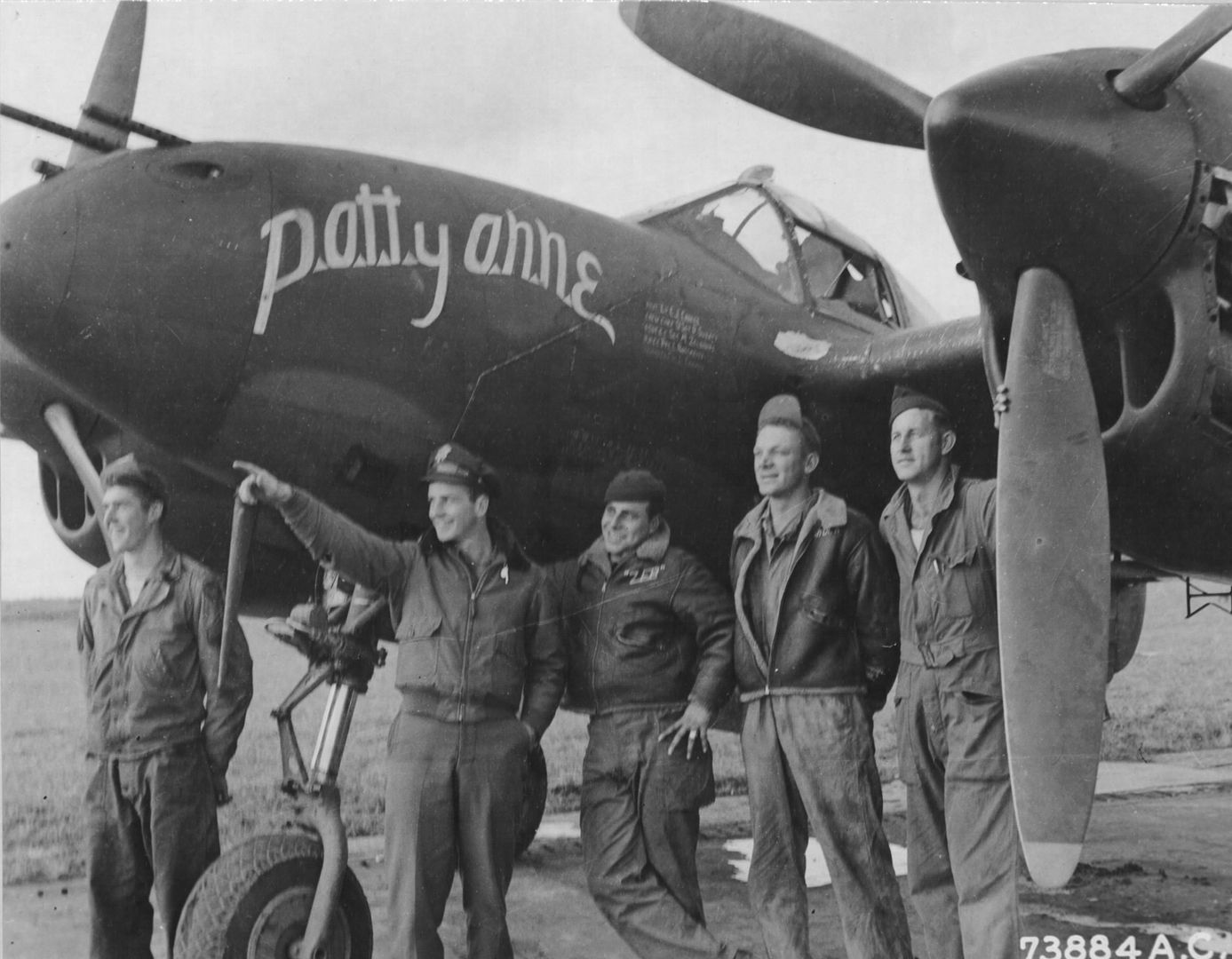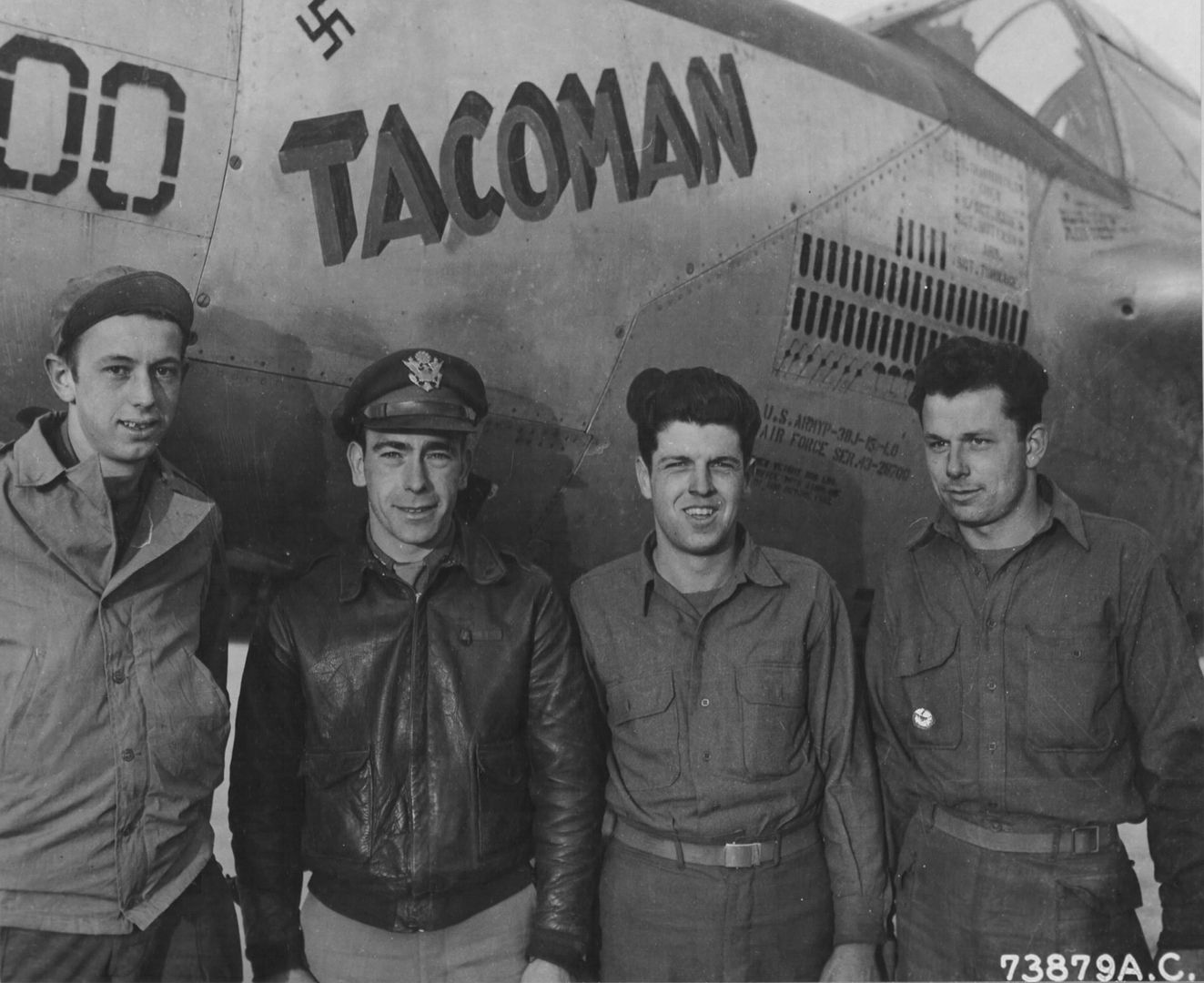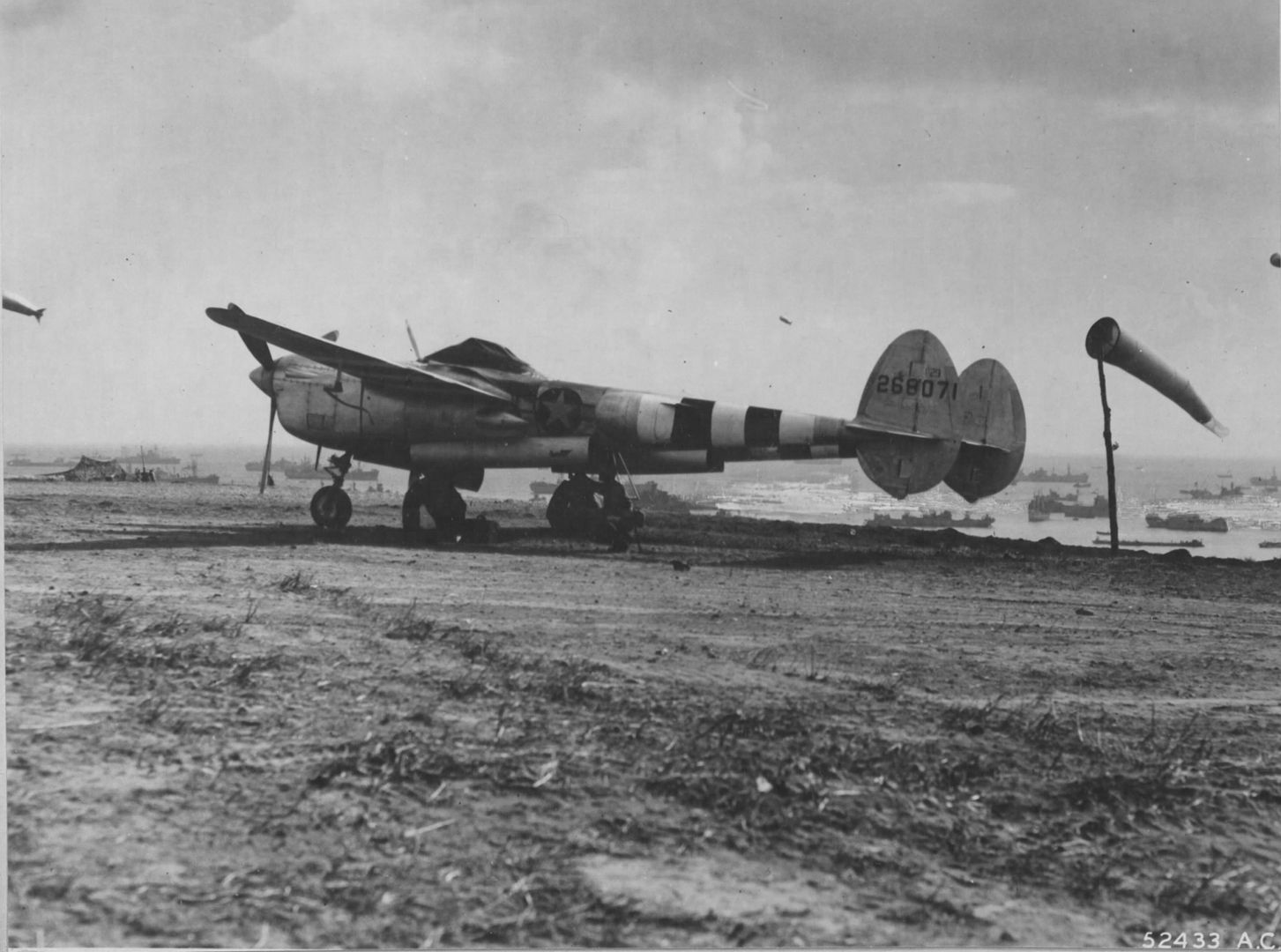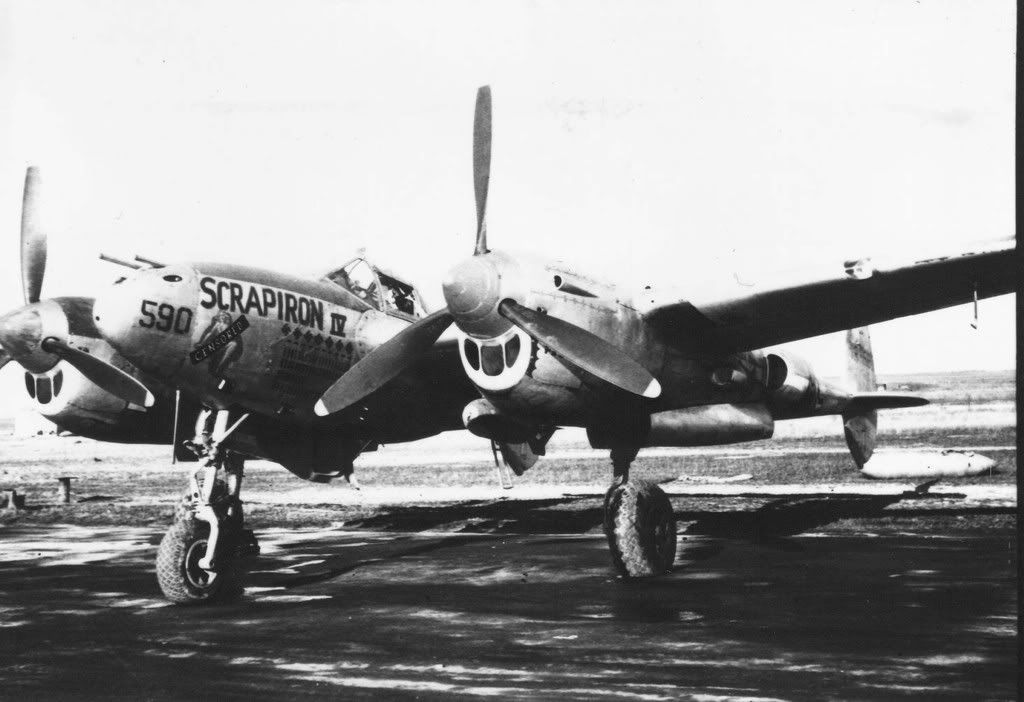Forums
- Forums
- Duggy's Reference Hangar
- USAAF / USN Library
- P-38's of the 367th FG
P-38's of the 367th FG
Post a reply
- Go to Previous topic
- Go to Next topic
- Go to Welcome
- Go to Introduce Yourself
- Go to General Discussion
- Go to Screenshots, Images and Videos
- Go to Off topic
- Go to Works in Progress
- Go to Skinning Tips / Tutorials
- Go to Skin Requests
- Go to IJAAF Library
- Go to Luftwaffe Library
- Go to RAF Library
- Go to USAAF / USN Library
- Go to Misc Library
- Go to The Ops Room
- Go to Made in Germany
- Go to Campaigns and Missions
- Go to Works in Progress
- Go to Juri's Air-Raid Shelter
- Go to Campaigns and Missions
- Go to Works in Progress
- Go to Skinpacks
- Go to External Projects Discussion
- Go to Books & Resources
-
11 years agoThu Jun 05 2014, 02:32pm
 Main AdminTEXT FROM HERE - http://www.367thfightergroup.com/367hist.htm
Main AdminTEXT FROM HERE - http://www.367thfightergroup.com/367hist.htm
A Tribute to the 367th Fighter Group
by Edwin S. Chickering
Group Commander - November 1944 - September 1945
Memorial Service, Air Force Museum
Dayton, Ohio, July 30, 1988 (Edited for use on the WWW - 8 December 1998)
The 367th Fighter Group was activated at Hamilton Field, California on July 15, 1943. That Summer and Fall the cadre of the Group slowly increased and P-39 aircraft arrived. In December the three squadrons, the 392nd, 393rd and 394th were scattered to three different fields in the San Francisco Bay area. Dive bombing and gunnery training was carried out at Tonapah, Nevada. In January 1944 the 367th was beefed up with personnel from the 328th and 368th Fighter Groups. Lieutenant Colonel Charles M, Young who had been commander of the 369th became commander of the 367th Fighter Group. Training continued into February at which time all overseas inspections were completed and the Group was declared ready to move to a combat zone. The training had been costly - eight pilots having been killed in the P-39s. The Group's journey to the European Theater began with entrainment in Oakland California on March 8, 1944. A six day train trip across the country was followed by a week of final inspections and training at Camp Shanks, New York before boarding the British liner Duchess of Bedford in New York Harbor. The ship was soon renamed the Drunken Duchess by her passengers during the 11 day convoy trip across the North Atlantic. The Duchess docked at Greenock, Scotland on April 3rd and the Group was transported by train to its airfield at Stony Cross, England. Having trained on single engine aircraft the pilots had expected to find P-51 Mustangs, but were surprised to find 75 P-38 Lightning's sitting on the dispersal pads. The change from single engine to twin engine aircraft required considerable retraining. With spirit and enthusiasm the 1,000 men of the Group pitched in and by early May the 367th was ready for combat. The first two combat missions were completed successfully and the 367th was at war. Fighter sweeps, bomber escorts and dive bombing missions were the order of the day for the Ninth Air Force units. Many sorties were scheduled and successfully completed. The pilots were gaining respect and confidence in the P-38. Prodigious effort by the ground crews and support personnel kept aircraft combat readiness high. Unfortunately, the baptism of fire over Festung Europe resulted in seven pilot casualties. D-Day, June 6th, arrived and the Group flew nine missions in the next three days maintaining low aerial cover over the invasion troops. By mid June, the Contain Peninsula had been cut-off and the German ground forces had withdrawn into a perimeter defense of Cherbourg, a major port which had become extremely important to the allies due to the storm damage to the artificial port facilities on the invasion beaches. A three division attack ordered for June 22nd was to be preceded by a low level bombing and strafing attach by 12 Ninth Air Force fighter groups. The 367th was to be the last fighter group over this highly defended area and would be followed by a massive Ninth Bomber Command attack from medium altitude. the fighters were ordered to fly at low altitude from west to east through this five by 26 mile highly defended area. The 367th P-38s were "sitting ducks." Major Rodgers, leading the 392nd Squadron returned with only seven undamaged aircraft. Major Smith, the experienced Flying tiger pilot leading the 393rd squadron was killed. Within two to three minutes after entering the area the 394th had lost five pilots. The mission was an unqualified disaster - seven pilots killed in action (KIA). All but 11 of the returning aircraft had extensive battle damage. The 367th was out of action for several days. During the 17 day period, including the operations in the Cherbourg area, the 367th had 14 pilots killed and one taken prisoner. The last week of July the Group's forward echelon crossed the English Channel on Liberty ships and landed in France with the 392nd Fighter Squadron moving to Carentain, the 393rd to Criqueville, and the 394th to St. Mere Eglise. Life in Normandy was quite different - pup tents, squad tents, fox holes, plenty of C and K rations, pierced steel plank runways and thousands of yellow-jackets in the jam and jelly. With the break out of the ground forces from the St. Lo area, close air support of Patton's Third Army became the order of the day. The Groups first big bag came with attacks on the German Seventh Army which, to prevent being surrounded, was withdrawing eastward through the gap between Falaise and Argentan. Five convoys and 100 Tiger tanks were destroyed on one day. A resurgence of Luftwaffe activity occurred in August with the 367th in the middle of the fray. On August 22nd the Group was ordered to attack, simultaneously, three separate airfields in the Laon area. The 392nd Squadron, led by Major Rogers, dive bombed and destroyed two hangers on one airfield but were jumped by 12 FW 190s as the completed their attack. Major Rogers called the other squadrons for help. The 393rd was jumped by 18 ME 109s and FW 190s as they reformed from their dive bomb run. Lt Buchanan shot down one but two Germans cornered Lt Awtrey and shot off his canopy. Without a canopy, Awtrey out maneuvered the two and riddled one of them. Lt Stanley Johnson called to report that he was bailing out of his aircraft which had been shot to pieces. Johnson's parachute was seen to open but he was never heard of again. After bombing its target, the 394th Squadron, led by Lt Pieper, turned to help the 392nd. His flight bounced four Germans but in turn were attacked by three others. One of the FW 190s shot out one of Lt Pieper's engines but was destroyed in turn by Pieper's wingman, Lt Lee. The fight continued with the 394th shooting down six additional aircraft including one destroyed by Lt Pieper flying with one engine feathered. In the mean time, the 392nd had taken care of itself, destroying five enemy aircraft without a loss. Victories were by Lieutenants Hartwig, Kines, O'Donnel, Diefendorf and Markley. Altogether the Group had destroyed 14 enemy aircraft for a loss of one. Returning to the Laon area on August 25th, the 367th Group simultaneously attached three Luftwaffe airfields at Clastres, Perone and Rossiers. The dive bombing attacks ignited one of the greatest fighter versus fighter air battles in U.S. history. It was unique in that most of the action took place in a relatively small area and from 3,000 feet to ground level. There are still witnesses to this dramatic event who refer to it as the "The day the sky over I'Aisne was on fire." (See Chapter 12 of "Quand le Ciel de I'Aisne Etait en Feu" by Jean Hallade.) The fight started when Major Gardner, leading the 392nd Squadron, radioed the other two squadrons the location of 30 FW 190s that had just taken off. He led his flight on the initial attack and four FW 190s fell simultaneously. Before the cover flight could reach them, Major Gardner and the other three members of his flight were surrounded and shot down. Captain Mateson leading the cover flight shot down two, Lt Lezie damaged one and destroyed another. Lt Platt shot down another while Lt Tremblay hit the wing root and cockpit of another FW 190. After driving three 190s from the tail of a P-38, Lt Lemley had his right engine shot out, but was able to escape at tree top level. Lieutenants Broniee and Conney were shot down and killed in action. With the 392nd and 393rd Squadrons joining the fight the odds were more even. Major Griffin leading the 392nd attacked from out of the sun and shot down one FW 190 and damaged another as did Lieutenants Livingston and Plotecia. Captain Blumer leading the 393rd and with Lt Awtrey on his wing destroyed five enemy aircraft becoming an ace on one mission. Lt Pacek flying his third combat mission shot down two and Lieutenants Dobrowolosk and Melvin Jones destroyed one each. Of the 50 enemy aircraft engaged, 25 were destroyed, one probably destroyed and 17 damaged. The 367th lost two pilots KIA. Four other bailed out over enemy held France. In the afternoon the 367th destroyed 16 JU 52s while on a long range strafing mission to airfields in the Dijon-Bordeaux area. For its achievements on August 25th, the 367th Fighter Group received the Presidential Unit Citation, the highest possible award for a unit in combat. By now the Allied forces were moving forward and it was time for the three squadrons to start leap-frogging to new bases; moving from bases in Normandy to LeMans, to St. Quentin and by late October to Juvincourt, north of Reims. We can never forget the welcome the French gave us at these fields - placing flowers on the aircraft and strewing flowers and vegetables along the runway. The Sunday promenade was an unforgettable sight. Now the flying missions were predominantly interdiction, that is, dive bombing and strafing trains, motor transport, bridges, marshaling yards and supply areas. The 367th also supported the air drop of Nijmegen by escorting C-47s and destroying the flak positions. For successful combat activity that Fall, the Group was awarded an Order of the Day Citation of the Belgium Army. The Luftwaffe, now operating from German soil, reacted vigorously to the 367ths attacks. An engagement on October 20th is particularly worth mentioning. The Group, now low on P-38s, was ordered to simultaneously attack three railroad bridges in the Duren area. Lieutenant Estabrook, leading seven P-38s, from the 394th squadron was jumped by 16 FW 190s on his dive bombing run. Three pilots failed to return, three returned badly damaged and Lt Bradford was killed in action. Lt Malone, leading the 392nd Squadron, was jumped by 25 FW 190s on his dive bombing run. Lieutenants Malone and Mathisen bailed our of their badly damaged aircraft and were taken prisoner while Lt Andrews and the experienced and highly respected Deputy Group Commander, Lt Colonel Morris Crossen were killed. Major Carroll Joy, leading the 393rd Squadron, turned to help the other squadrons on completing his bomb run and found Lt Bowers of the 394th being attacked by seven FW 190s. He destroyed two and Lt Eldridge destroyed another. Altogether the 367th had destroyed 10 enemy aircraft, but seven of our pilots failed to return, three having been killed in action. During this time, pilots were being decorated with Distinguished Flying Crosses (DFCs) and Air Medals. Some were returning to the States with combat tours completed. Pilots were not the only ones receiving awards. Nine airmen received the Bronze Star. On November 9th, Colonel Young completed his tour and was succeeded by Colonel Edwin S. Chickering. Cold weather was now approaching and the Group bedded down at Juvincourt, on an old German air base with more permanent facilities. Life settled into a routine with bad weather curtailing some of the flying activities and adding to their hazard. There were liberty runs to Reims, an EM Club, more movies and a good basketball team. Missions from Juvincourt consisted mainly of fighter sweeps, bomber escorts, dive bombing and strafing of bridges and transport. Luftwaffe reaction continued. On November 19th Major Brooks destroyed three enemy aircraft while coming to the rescue of a P-47 under attack. Captain Blumer added another. Altogether the 393rd and the 394th Squadrons destroyed seven with no losses to themselves. The German Ardennes Offensive occurred as the holidays approached. A planned move to a field in Belgium was canceled. On the night of December 18th a Forward Air Control Team from the 393rd Squadron was sent to Bastogne to assist the 101st Airborne Division. The team consisted of an experience flight commander, Captain James Parker, a radio operator, a driver and a radio equipped jeep. The team joined the 101st just an hour before the last road to Bastogne was cut. When the weather finally broke, Parker did a superb job of directing the flights of fighter aircraft that were reporting in to him. Bastogne was saved due to the guts and determination of the 101st Airborne Division, Captain Parker, and the Ninth Air Force fighter bomber pilots. On Christmas Eve the 367th, after escorting C-47s on a re-supply drop at Bastogne, conducted an armed reconnaissance of the Trier area. The 394th Squadron was jumped by FW 190s and a 40 minute air battle ensued in which Lt Jessie DeFrance bailed out of his burning P-38 and was taken prisoner, Lt Baxter was killed and Lieutenants Croker and Mygatt were badly shot up but were able to return to base. The Group claimed eight destroyed and two probably destroyed and nine damaged. On Christmas Day, Lt Harry Curtis was killed while strafing half-tracks behind the Battle of the Bulge. During the holiday season the enlisted men hosted and entertained 50 French orphan children, providing candy and small gifts. Throughout our moves in France, the officers and men continuously assisted in the welfare of the citizens surrounding our hastily made airfields. As the year 1945 commenced, and with a shortage of P-38s due to losses, a decision was made by higher headquarters to re-equip the Group with P-47 Thunderbolt aircraft. Transition commenced with pilots flying P-38s on combat missions and P-47s on training missions. On February 16th the 393nd Squadron flew the first combat missions in P-47s. As the war progressed, the P-47s were kept busy, in one instance maintaining a ten hour patrol over the Remagen Bridge. The untiring crew chiefs, armorers, sheet metal repairmen, cooks, intelligence personnel, weather officer, surgeons, clerks and staff were working as a well forged team. R&Rs were provided and some rotated to the States on leave. Also for a second time, our Group was cited in a Belgium Army Order of the Day. On March 19th, 1945 a special maximum strength mission was scheduled to destroy a castle and complex near Bad Nauheim, Germany housing the German Army Headquarters for the entire Western Front. the headquarters of Field Marshal Kesselring who had recently replaced Field Marshal Von Rundstedt. History reported that Hitler's Minister of War Production, Albert Speer, was also there. The attack was scheduled for 1330 hours, the time the senior staff and commanders were expected to be lunching. The initial attack was to be made at minimum altitude by Major Matheson leading 16 P-47s of the 394th Fighter Squadron, each aircraft loaded with two 1,000 pound bombs with delay fuses. Having difficulty navigating at low level due to unexpected haze, the 394th was not able to attack as scheduled. Fortunately, Major Mateson's difficulties did not alert the headquarters' defenses and Lt Diefendorf, leading 16 P-47s loaded with 1,000 pound bombs with .01 second nose fuses was able to surprise the headquarters by initiating his dive bomb attack from 7,000 feet. Lt Diefendorf's bombs made a direct hit on the castle; however, the German generals escaped into deep underground bunkers. General Kesselring did receive a scalp wound from a falling chandelier. The 394th made their attack as the 392nd completed theirs. The 16 P-47s of the 393rd Squadron led by Major Slingerland were loaded with napalm to burn-up anything remaining. The bombs and napalm reduced the military complex to ruins, causing many casualties and disrupting communications and the flow of intelligence at a critical time when the Allies were crossing the Rhein. For this successful undertaking the 367th Fighter Group was awarded an Oak Leaf Cluster to the Presidential Unit Citation. As our ground forces crossed the Rhein and forced their way deeper into Germany the 367th's interdiction mission accounted for the destruction of much motor and rail transport, tanks and supplies. We were commended by the Commanding General of Twelfth Corps for superior close air support of his divisions. In addition our excellent basketball team went on to win the Ninth Air Force finals but lost the championship in a close game. On April 10th the Group moved to an airfield on the northwest side of Frankfurt, Germany. Life here was quite different. KP was done by displaced persons and the officers turned in their field equipment and moved into two hotels in the nearby town of Bad Soden. However, the war was not yet over, Mid-April saw the Group destroy 70 enemy aircraft. Many missions were to furnish continuous air cover over the advancing U.S. armored divisions. At one time the Commanding General of the 11th Armored Division, General Dager, flew into our base to personally shake the hand of every pilot who had flown on a mission the day before that had saved his armored columns from disaster. The 367th had put to route a German Panzer division destroying many of their tanks. About this time General Weyland presented Group Personnel with two Silver Stars, two Purple Hearts, five DFCs and 17 Bronze Stars. Our last combat mission was flown on May 8th. All hostilities ceased on May 9th V-E Day, exactly one year after the Group became operational. Some local flying continued and on June 4th the 367th led a long line of Ninth Air Force groups in a fly-by viewed by General Weyland. By now the point system was in effect and some personnel were rotating to the States. On July 1st it was announced the 367th was to go to the Far East. Only four of the 15 Ninth Air Force fighter groups were selected for this redeployment showing the respect that the 367th had developed. The move was to be made through the Panama Canal and direct to the Philippines where the Group would be re-equipped with P-47Ns in preparation for the invasion of Japan. The Group moved to Camp Detroit in France and after a month there moved to a staging area near Marseille. Here the Group was split and loaded on two ships, the USS General Morton, and the USS John Ericcson. About this time the Twentieth Air Force dropped the two atomic bombs and Japan surrendered. The Morton was diverted to Newport News, Virginia and the John Ericcson sailed for Staten Island, New York. The few personnel that remained in the Group after leaves, transfers and discharges reassembled at Seymour Johnson Field, North Carolina on November 2nd. On November 7, 1945 the 367th was inactivated. The 367th had participated in seven European Campaigns rolling up an impressive list of statistics. The pilots had flow 14, 175 combat sorties destroying 432 enemy aircraft, probably destroying another 28 and damaging 344. They had destroyed or badly damaged 384 locomotives, 4,672 motor vehicles and 8,288 railroad cars. The important thing is not the statistics, but the effect these combat sorties had on the outcome of the war. The Group's bomber escorts, attacks on enemy airfields and destruction of enemy aircraft in air-to-air combat materially contributed to the gaining of air superiority over Europe to the point where German forces could not move, except in darkness or adverse weather, without fearing devastating attacks from the air, while Allied forces moved about with impunity. The Group's attacks on bridges and enemy lines of communication materially prevented or delayed the German Army from moving troops and supplies to counteract the Allied advances. The Group spearheaded the attacks by our ground units by acting as eyes to see what was out ahead of them and destroying opposing forces. And the 367th struck at the very heart of the German Wehrmacht destroying the headquarters for Commander in Chief West at a critical stage during the Allied crossing the Rhein. The 367th Fighter Group contributed greatly to the defeat of Hitler's Germany. For their accomplishments the Group received two Presidential Unit Citations, two Belgium Army Order of the Day Citations and many letters of commendations. These awards or recognition were the result of the professional and dedicated efforts of all the personnel of the Group, pilots and ground personnel, officers and enlisted men. The accomplishment of our Group, as in any armed conflict, is overshadowed by the inevitable casualties that occur. We lost 92 very close, very personal comrades. Some remain in final resting places on foreign soil and others, missing in action, are forever inscribed on the Tablets of the Missing in American Cemeteries overseas. And so, we are here today, some 45 years later, to honor the men of the 367th Fighter Group, not only those who gave their lives during the war, but also those who have died since, and those who have yet to make their last flight. We pay tribute to the officers and the enlisted men, the pilots and the ground personnel, all of whom played an important part in making victory in Europe possible. In the Pentagon, as you go up the wide steps that lead to the offices of the Secretary and Chief of Staff of the Air Force, there is a large mural 20 or more feet wide showing a large force of B-17s and B-24s drawing contrails as they penetrate deep into enemy territory escorted by fighters. The inscription, taken from the Bible, reads: "Whom shall I send and who will go for us? Then said I: Here am I, send Me." When the country need them the most the men of the 367th Fighter Group said - Send me, send me." We honor these men as we unveil this plaque in this beautiful memorial park. A salute to the 367th and all of its personnel - Well done.










































-
11 years ago
 AdminGreat images - if all the codes and serials of these a/c are known this would be a well skinning project.
AdminGreat images - if all the codes and serials of these a/c are known this would be a well skinning project.
ATB
Armin -
 AdminDuggy you are a goldmine
AdminDuggy you are a goldmine
Post a reply
- Go to Previous topic
- Go to Next topic
- Go to Welcome
- Go to Introduce Yourself
- Go to General Discussion
- Go to Screenshots, Images and Videos
- Go to Off topic
- Go to Works in Progress
- Go to Skinning Tips / Tutorials
- Go to Skin Requests
- Go to IJAAF Library
- Go to Luftwaffe Library
- Go to RAF Library
- Go to USAAF / USN Library
- Go to Misc Library
- Go to The Ops Room
- Go to Made in Germany
- Go to Campaigns and Missions
- Go to Works in Progress
- Go to Juri's Air-Raid Shelter
- Go to Campaigns and Missions
- Go to Works in Progress
- Go to Skinpacks
- Go to External Projects Discussion
- Go to Books & Resources
